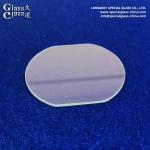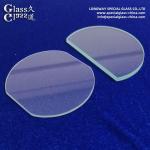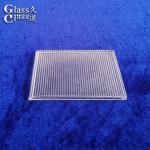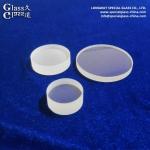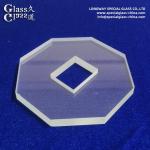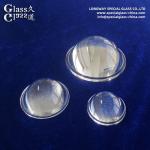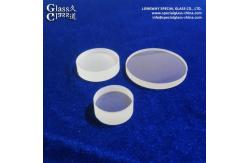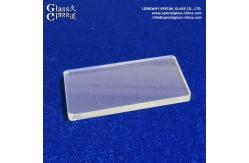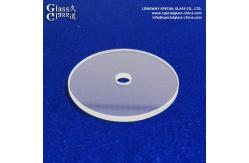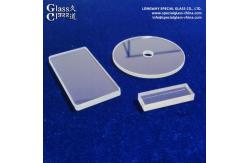Custom Precision Borosilicate Glass Lenses In High-temperature
Industrial Sensors
Material: Core Composition: Engineered borosilicate glass,
primarily composed of silica (SiO₂ ~80%) and boron trioxide (B₂O₃
~13%), with additions of alkalis and aluminum oxide. Key Variants: Often Schott Borofloat® 33, Pyrex®-type, or
equivalent high-performance borosilicate formulations chosen for
specific thermal/chemical needs.
Key Properties: Exceptional Thermal Stability: Low Coefficient of Thermal Expansion (CTE): Typically ~3.3 x
10⁻⁶/K, minimizing dimensional change and stress under rapid or
extreme temperature fluctuations. High Thermal Shock Resistance: Withstands sudden temperature
changes (ΔT > 150°C) without cracking, critical for processes
like furnace entry/exit or quenching.
High Temperature Endurance: Maintains structural integrity and
optical clarity continuously at temperatures often exceeding 450°C,
with short-term peaks significantly higher. Chemical Durability: Highly resistant to water, acids,
alkalis, and solvents, preventing corrosion or clouding in harsh
industrial atmospheres. Optical Clarity & Transparency: High transmission across
relevant wavelengths (often visible to near-IR) essential for
accurate light signal transmission in sensors. Mechanical Rigidity & Hardness: Provides structural
stability and resistance to abrasion or particulate impact. Precision Manufacturability: Can be custom-ground and polished
to tight tolerances (surface figure, centration, thickness) for
specific optical requirements.
Primary Function: High-Temperature Optical Transmission Window: Acts as a
robust, clear barrier protecting sensitive internal sensor
components (detectors, electronics, optics) from extreme heat,
corrosive gases, dust, and pressure differentials. Precise Light Path Control: Ensures accurate transmission,
focusing, or collimation of light signals (e.g., infrared radiation
for pyrometry, laser beams for alignment, visible light for
inspection) within the sensor system, unaffected by thermal
distortion. Environmental Sealing: Forms a hermetic or near-hermetic seal
crucial for maintaining sensor calibration and protecting internal
electronics.
Critical Applications: Non-Contact Temperature Sensors (Pyrometers): Viewports and
focusing lenses directly exposed to molten metals (steel, aluminum,
glass), hot kilns, furnaces, reactors, and welding processes. Laser-Based Sensors: Windows and optics in laser distance
sensors, displacement sensors, and level sensors used in hot
environments like metal processing, glass manufacturing, and
semiconductor fabrication. Process Monitoring & Control: Lenses in cameras and
optical sensors for high-temperature industrial inspection (e.g.,
glass forming, metal casting, ceramic sintering, semiconductor
wafer processing). Combustion Monitoring: Optics in flame scanners and combustion
analyzers within boilers, gas turbines, and incinerators. Gas Analysis Sensors: Windows protecting optical cells in
Tunable Diode Laser Absorption Spectroscopy (TDLAS) and other
analyzers in hot, corrosive exhaust streams or process gases. Semiconductor Manufacturing: Optics in sensors for
lithography, etching, and deposition tools requiring thermal
stability and chemical purity.
Summary: Custom precision borosilicate glass lenses are vital components enabling reliable operation of industrial
sensors in extreme heat and harsh environments. Their unique
combination of ultra-low thermal expansion, high thermal shock
resistance, chemical durability, and optical clarity allows them to
function as robust, stable optical windows and precise
light-guiding elements. By protecting sensitive internals and
ensuring accurate signal transmission, these custom lenses are
essential for critical process control, safety monitoring, and
quality assurance in demanding industries like metals, glass, power
generation, chemicals, and semiconductor manufacturing.
| Name | Glass Lens, Glass disc, Sight glass | | Material | Pyrex, borosilicate glass, | | Diameter Tolerance | +0/-0.2 mm | | Thickness Tolerance | +/-0.2 mm | | Processed | by molding, grinding, polishing | | Working temperature | resisting high temperature shock | | Surface Quality | Optical grade | | Transmission | above 92% | | Chamfer | 0.1-0.3 mm x 45 degree | | Surface Coating | Available | | Usage | Optical system, Photographic sysem, Lighting system,Electronic
apparatus, |
|
